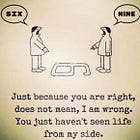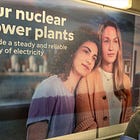
“If I had never dropped in on that single course in college, the Mac would have never had multiple typefaces or proportionally spaced fonts" - Steve Jobs on how attending a calligraphy class helped shape Apple
In the Black Mirror episode “White Bear,” a woman awakens with amnesia to find herself in a dystopian world where she is being hunted. The shocking revelation comes later: she is serving a sentence for murdering a young girl and filming the crime. Her punishment involves being trapped in a psychological loop, forced to relive her crime each day as she's made to watch footage of it before her memory is wiped. She is condemned to relive the same terrifying day repeatedly, with spectators silently recording her suffering - creating a disturbing parallel to her own act of filming violence.
This episode explores how technology could enable the weaponisation of memory and consciousness as tools for punishment. The narrative is one of fear: that digital media could erode our empathy, potentially allowing us to justify dehumanisation when it serves our collective sense of justice and desire for entertainment.
In contrast, in the real world, we are harnessing similar technology for far more positive purposes. Virtual reality (VR) technology is now being used for rehabilitation rather than retribution. Correctional facilities in California use VR programs that foster empathy by allowing inmates to understand their victims' experiences, which reduces reoffending rates. VR is also used to prepare inmates for successful reintegration into society after incarceration. There are numerous other examples of it being used for the benefit of humanity.
Since science fiction predominantly focuses on dystopian scenarios, despite technology also presenting opportunities for positive, humane solutions to society's biggest challenges, who is exploring these optimistic possibilities?
It’s not self-described 'techno-optimists' - they also often fall into the same trap of doom-and-gloom thinking as degrowth advocates, with both groups fixating on supposed civilisation decline and collapse. Certainly, it often feels like bad news is everywhere, with new conspiracy theories emerge daily, and people scrambling to contain them.
In this post I explore different approaches that have been shown to be effective in tackling misinformation:
According to the National Science Foundation (NSF) in the US, science literacy among American adults is around 28%, based on the ability to answer questions correctly about scientific facts and concepts. The National Science Board (NSB) Science and Engineering Indicators 2020 reports that science knowledge - the ability to answer basic science questions - among US adults is in the range of 25% to 30%, depending on the survey and the specific questions asked.
But surely we have exhausted the conversation about problems - we know what they are. At an event in Westminster that I spoke at recently, an audience member asked an essential question: “Can we fix…everything? How?” There wasn’t time to give a full response then, so here it is.
Rewiring cognition
I don’t think it’s a coincidence that the only pro-nuclear Green Party in the world is Finnish, since Finland is renowned for its progressive education system, which I discuss in this post:
I’ve also discussed cognitive biases before and how they often lead us to believe misinformation, such as confirmation bias - where we unknowingly seek out information that supports our pre-existing beliefs - and groupthink, where we align with the views of our social group. Developing awareness of these biases is crucial for enhancing science literacy.
Improving science literacy and tackling misinformation are critical steps toward building a more informed and resilient society, especially in an age where misinformation spreads so rapidly through social media and personal networks. A scientifically literate population is better equipped to make informed decisions on key issues and new technologies, and protected from incoming informational attacks from other countries. By looking at what the countries with the highest science literacy rates are doing, we can develop a plan for how to solve these problems at home.
So, how do we achieve this? By prioritising critical thinking skills alongside scientific knowledge, and by teaching students how to assess sources, question claims, evaluate evidence, and understand the scientific method. The focus should be on how to think, not what to think, which stands in contrast to traditional rote learning methods. While some may not like it (I’m looking at you, anti-humanities folks), this approach involves integrating STEM with the humanities, much like Finland has done so successfully. Science doesn't exist in isolation - it flourishes in an interdisciplinary context. By connecting science to history, economics, ethics, and even art, people can grasp its wider societal importance and application.

We also need to incorporate new technologies into education. As usual, China is ahead of the game, already making AI education mandatory for students in Beijing.
Building media literacy skills
We need to teach people - children and adults - to distinguish between credible and non-credible sources of information. Training programs in schools, libraries, and workplaces can teach people how to evaluate scientific claims, check credentials, use fact-checking tools, identify biases in reporting, and so on.
Traditional journalism also needs a major overhaul. Media outlets can play a more proactive role in combating misinformation, not by pushing their own biases, but through highlighting scientific consensus and clearly explaining what it is (this would be especially valuable for loaded topics like nuclear energy and gene editing). They can also focus on fact-checking articles and providing clear, accessible explanations of complex scientific issues. To make this possible, journalists and editors also need to undergo science literacy training, and be held to account by an unbiased body (AI could easily fulfil this role).
Increasing scientific communication
If this seems obvious, you may be surprised by how many scientists oppose the idea of communicating science. When the popular show Cosmos, hosted by Carl Sagan, was proposed in the 1980s, some scientists were against it because they felt that it would simplify complex scientific concepts too much and lack technical detail.
The theoretical physicist Richard Feynman was also known for his critical views of science communication. In The Pleasure of Finding Things Out, Feynman argues that popularised science “dumbs down” the complexity of science for the public: “If you don't know something, you can find it out. That's the key to science. But when you write about it, you can only write about a simplified version that can lead to all kinds of misconceptions.”
Apologies to the Feynman fans, but his reasoning is flawed here. It aligns with what we (in the field of science communication) refer to as “the deficit model,” where Feynman assumes that the public's lack of understanding or acceptance of scientific knowledge is simply down to a deficit of information. The assumption is that if people have more facts, the problem will go away. If only it was so simple. The deficit model treats people as passive recipients of expert knowledge, which is wrong because it oversimplifies the relationship between science and society, overlooking complex factors that influence public opinion, including values, emotions, trust, and cultural beliefs. Note the irony that Feynman said he was concerned with oversimplification of scientific topics, but then proposed a simplified (and flawed) approach to resolving it.
Science and storytelling require different skill sets. Science demands an attention to detail and precision, while storytelling involves being able to step back to see the bigger picture, and - yes - simplify the relevant details for the audience in front of you. This means that scientists aren’t always the best communicators, but the consequence is that storytelling is then left to people who are actively anti-science or have low science literacy. To address this, scientific institutions can use skilled communicators to bridge the gap and ensure that accurate information reaches the public before it is distorted by other voices.
It’s not enough to simply debunk false claims. Educators and communicators also need to address the emotional appeal behind those claims, to understand why people believe in them, and offer alternative narratives that feel personally relevant. We need more storytelling in science.
Embracing technology as part of the solution
People are quick to blame technology for the spread of misinformation, but as the example of VR demonstrates, technology can also be part of the solution.
One obvious measure when dealing with information online is to employ more AI-generated fact-checking, as it is quick and relatively unbiased. Social media platforms can also provide links to reliable sources as a way of correcting misconceptions immediately, or on-site fact-checking. The Community Notes feature on X is a good example of this, as is allowing AI (in the case of X, Grok) to answer questions directly in comments sections.
While the challenges we face are complex, they are not entirely new. Too often, they lead to the conclusion that societal problems are insurmountable, but in reality, the solutions are fairly straightforward. Improving science literacy requires a concerted and united effort across education, institutions, and society as a whole. By embedding critical thinking skills, improving media literacy, encouraging public engagement with scientists, addressing cognitive biases, leveraging technology, and promoting intellectual humility, we can empower individuals to make more informed decisions and combat the spread of misinformation. These combined efforts will help ensure that science remains a cornerstone in shaping a well-informed, rational, and forward-thinking society. Perhaps it sounds idealistic or unrealistic, but equally it seems futile to fixate on the problems without also planning solutions, and I admit that I am, at heart, an optimist.
If we can address this core issue, I feel sure that it will lead to solutions for virtually all of the other problems that we face as a civilisation. As a wise man once said, “To fail in trying is far worse than never attempting at all.”







More science literacy would be great, although I don't think discussions on social media are the problem. UK energy policy is not being driven by social media, or by anything the electorate asked for; if anything it's being driven by international bodies such as the WEF, the trade union of the very wealthy. Germany's extreme energy policy is an accident of their proportional representation system, in which the Greens (until the latest election) were needed to form ruling coalitions; ordinary Germans quite like nuclear power.
I am highly skeptical that AI-based "fact checking" would bring value to important and complex discussions. Perhaps it could address relatively simple falsehoods - like just about any number quoted by Donald Trump when justifying tariff imposition.
But could it provide a clear - and correct - answer to an enthusiast asserting that "solar power is cheaper, and we need more everywhere" Would it point out that the value of solar power depends on many factors - density of the solar resource (i.e. how sunny is it in that place?), grid penetration of intermittent renewables, storage and backup capacity available. And that the price of solar panels is probably one of the least important factors?